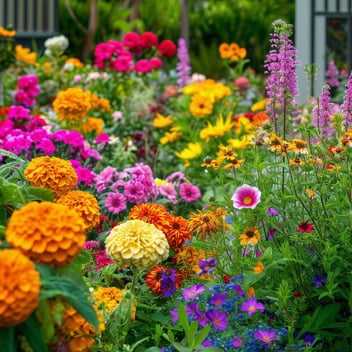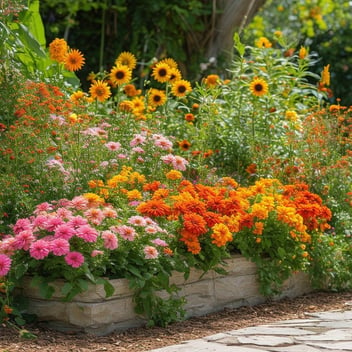The Ultimate Guide to Growing Annuals in SEQ Gardens
Introduction
South East Queensland (SEQ) boasts a climate that allows gardeners to cultivate a vibrant tapestry of annuals year-round. These ephemeral beauties infuse gardens with seasonal color, texture, and diversity, offering endless possibilities for creative expression.
Understanding SEQ's Subtropical Climate
SEQ's climate is characterized by hot, humid summers and mild, dry winters. This subtropical environment necessitates the selection of annuals that can withstand high temperatures and humidity, ensuring robust growth and enduring blooms.
Selecting Suitable Annuals for SEQ Gardens
When curating your garden, consider annuals that exhibit:
-
Heat Tolerance: Ability to thrive in elevated temperatures.
-
Humidity Resilience: Capacity to flourish despite high moisture levels in the air.
-
Soil Adaptability: Compatibility with SEQ's soil conditions.
Top recommended annuals include:
-
Marigolds (Tagetes spp.): Vibrant hues and natural pest-repelling properties.
-
Zinnias (Zinnia elegans): Diverse color palette and drought resistance.
-
Cosmos (Cosmos bipinnatus): Delicate blooms that tolerate poor soils.
-
Sunflowers (Helianthus annuus): Stately flowers that attract pollinators.
-
Salvias (Salvia spp.): Spiky inflorescences beloved by hummingbirds.
-
Impatiens (Impatiens walleriana): Shade-loving plants with continuous blooms.
-
Nasturtiums (Tropaeolum majus): Edible flowers with a peppery zest.
Seasonal Planting Guide
To maximize your garden's potential, align planting schedules with SEQ's seasons:
-
Spring: Introduce Marigolds and Petunias to attract beneficial insects.
-
Summer: Opt for heat-resistant varieties like Zinnias and Sunflowers, ensuring regular watering during peak heat.
-
Autumn: Plant Cosmos and Salvias to maintain vibrant displays as temperatures moderate.
-
Winter: Focus on frost-sensitive species such as Impatiens, providing protection during cooler nights.
Soil Preparation and Fertilization
Healthy soil is the foundation of a thriving garden. Begin by assessing soil pH and structure. Incorporate organic matter, such as compost, to enhance fertility and drainage. While organic fertilizers release nutrients slowly, promoting sustained growth, synthetic options offer immediate nutrient availability. Choose based on your garden's specific needs.
Watering Practices and Mulching
Efficient watering is crucial in SEQ's climate. Employ drip irrigation or soaker hoses to deliver moisture directly to the root zone, minimizing evaporation. Mulching with organic materials like straw or bark chips conserves soil moisture, suppresses weeds, and regulates temperature fluctuations.
Pest and Disease Management
Common adversaries in SEQ gardens include aphids, caterpillars, and fungal infections. Implement Integrated Pest Management (IPM) strategies by:
-
Monitoring: Regularly inspecting plants for early signs of issues.
-
Biological Control: Encouraging natural predators like ladybugs.
-
Cultural Practices: Ensuring proper spacing and air circulation to deter diseases.
Designing a Vibrant Annual Garden
To craft a garden that captivates the senses, consider the following design principles:
-
Color Schemes: Implementing thoughtful color combinations can transform your garden into a visual masterpiece. Utilize the color wheel to select harmonious hues that evoke desired moods. For instance, pairing bold 'Purple Wave' petunias with the softer purple of ageratum's powder-puff blooms creates a cohesive and striking display.
-
Plant Combinations: Strategically combining plants enhances visual interest and ecological balance. For example, the colorful leaves of coleus paired with the silvery foliage of dusty miller provide a rich tapestry of color and texture, ideal for shaded areas where vibrant flowers are hard to grow.
Maintenance and Deadheading
Regular maintenance ensures the longevity and vibrancy of your annuals:
-
Deadheading: Removing spent flowers, known as deadheading, encourages continuous blooming and prevents plants from diverting energy into seed production. This practice not only prolongs the flowering period but also maintains the plant's aesthetic appeal.
-
Pruning: Beyond deadheading, occasional pruning of leggy or overcrowded growth promotes air circulation and reduces disease risk, contributing to the overall health of your garden.
Conclusion
Cultivating annuals in South East Queensland offers gardeners an opportunity to create dynamic and colorful landscapes. By selecting climate-appropriate species, employing thoughtful design principles, and committing to regular maintenance practices, your garden can flourish throughout the seasons. Embrace the vibrant world of annuals and transform your SEQ garden into a living tapestry of color and life.




